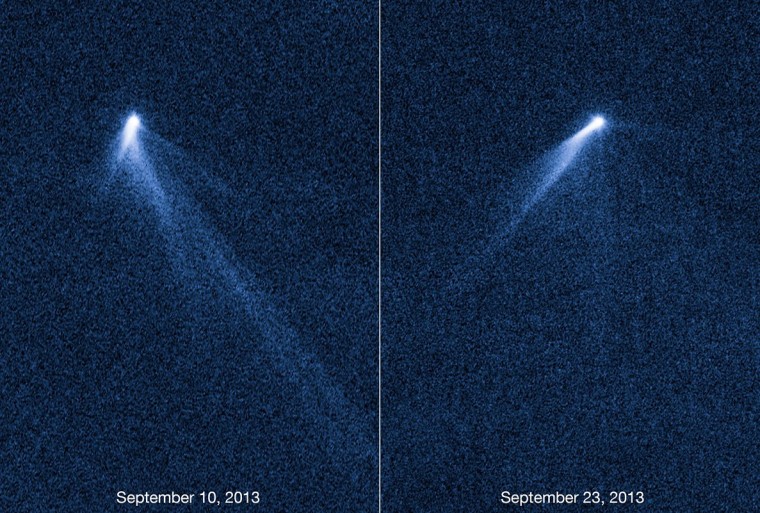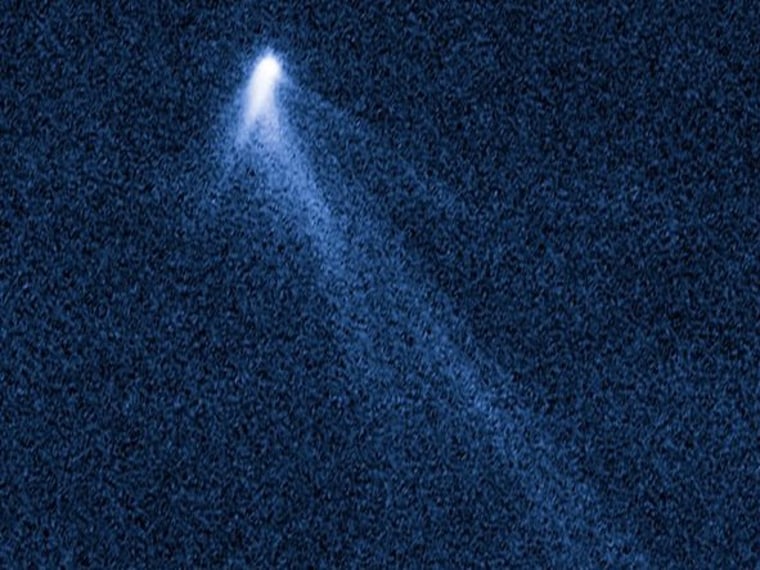
The Hubble Space Telescope has spotted one of the weirdest objects ever seen in the asteroid belt: a chunk of rock that's spinning around like an out-of-control lawn sprinkler, spraying out up to six comet-like tails of dust.
"We were literally dumbfounded when we saw it," lead investigator David Jewitt of the University of California at Los Angeles said in a NASA news release. "Even more amazing, its tail structures change dramatically in just 13 days as it belches out dust. That also caught us by surprise. It's hard to believe we're looking at an asteroid."
Jewitt and other scientists using the Pan-STARRS survey telescope in Hawaii announced the discovery of the 1,400-foot-wide (425-meter-wide) active asteroid, dubbed P/2013 P5, back on Aug. 27. But it wasn't until the team took a closer look with Hubble on Sept. 10 that they found the object was ejecting streams of dust.
When they looked again, on Sept. 23, the spray pattern had totally changed. "We were completely knocked out," Jewitt said.
Another member of the team, Jessica Agarwal of the Max Planck Institute of Solar System Research, fed the observations into a computer model and determined that the streams of dust could have been ejected in a series of six outbursts going back to April 15. Radiation pressure from sunlight would have stretched the dust into the streamers seen by Hubble.
The research team lays out a scenario for the asteroid's behavior in a paper published online in Thursday's issue of The Astrophysical Journal Letters. They suggest that solar radiation pressure could have set P/2013 P5 spinning like a top — to such a degree that the asteroid's loosely bound, dusty material would start sliding toward the equator, breaking up into dust and drifting out into space.
So far, only about 100 to 1,000 tons of dust have been lost. Astronomers plan to continue tracking P/2013 P5 to see if the dust is being ejected from the asteroid in its equatorial plane. That would be provide strong evidence for a rotational breakup.
This may turn out to be the way most small asteroids bite the dust, so to speak.
"In astronomy, where you find one, you eventually find a whole bunch more," Jewitt said in the news release. "This is just an amazing object to us, and almost certainly the first of many more to come."
Jewitt's familiar with that phenomenon: Back in 1992, he and fellow researcher Jane Luu discovered the first object after Pluto in the Kuiper Belt, the ring of icy objects that lie beyond the orbit of Neptune. In the two decades since then, more than 1,000 Kuiper Belt objects have been identified — so many that the International Astronomical Union decided to reclassify Pluto itself as a dwarf planet in 2006.
Pluto was once considered an odd duck in the solar system, but now it's seen as the first of many Kuiper Belt objects. Someday, P/2013 P5 may be considered the first of many comsteroids.
And by the way ... although P/2013 P5 may look like a comet, the evidence so far places it in the asteroid camp: Jewitt said it's apparently part of a larger asteroid that broke apart in a collision about 200 million years ago. Lots of other bits of space rock have been found in orbits similar to P/2013 P5's, and the meteorites from those bodies show evidence of being heated to as much as 1,500 degrees Fahrenheit (815 degrees Celsius).
If this scenario is correct, any ice would have been cooked out of P/2013 P5 and its rocky kin long ago. And if there's no ice, it's not a comet.
More about comets and asteroids:
- 'X' marks collision between asteroids
- Flash interactive: The new solar system
- NBC News archive on comets | asteroids
In addition to Jewitt and Agarwal, the authors of "The Extraordinary Multi-tailed Main-Belt Comet P/2013 P5" include Harold Weaver, Max Mutchler and Stephen Larson.
Alan Boyle is NBCNews.com's science editor. Connect with the Cosmic Log community by "liking" the NBC News Science Facebook page, following @b0yle on Twitter and adding +Alan Boyle to your Google+ circles. To keep up with NBCNews.com's stories about science and space, sign up for the Tech & Science newsletter, delivered to your email in-box every weekday. You can also check out "The Case for Pluto," my book about the controversial dwarf planet and the search for new worlds.
